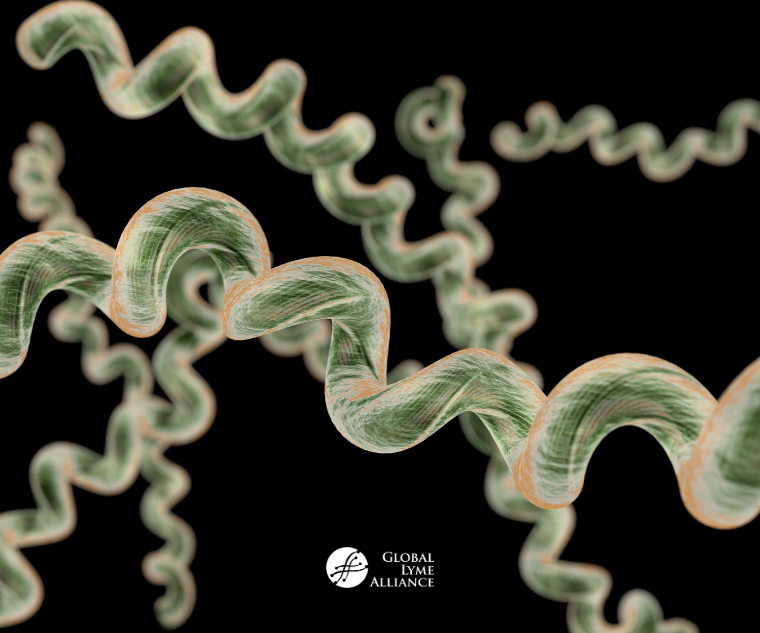
by Jennifer Crystal
Lyme disease is a complex illness, not just because it manifests in the body in different ways, but because it is also very difficult to diagnose. The Lyme disease bacterium itself, Borrelia burgdorferi, is a high-functioning organism called a spirochete. It doesn’t react to medication as other illnesses do. People have trouble pronouncing it. In this article, I will unravel the mystery of the spirochete: what it is, how it works, what it feels like in an infected person, and how patients can best obliterate it.
Spiro-whats?
I have heard every possible pronunciation of spirochete, from speer-o-shet, to spy-ro-shet-tees, like agricultural machetes. The correct pronunciation is spy-ro-keet. The name is derived from the shape of the bacteria, which is spiral like a corkscrew. Another spiral-shaped bacteria you may be familiar with is syphilis. While the illnesses are different, both are marked by coiled bacteria that twist and move, making them difficult to catch and treat in the body.
Spirochetes are savvy. They spiral away from antibiotics, burrowing into bones, cells, joints, and nerves. They can even cross the blood-brain barrier, bringing Lyme disease into your central nervous system. They replicate and spread; all it takes is one dormant spirochete to start reproducing for a Lyme infection to flare up. This is why late-stage Lyme—which goes untreated for a long time and has spread around the body and into the central nervous system—is difficult to treat, if not virtually impossible to fully eradicate.
How does a spirochete function?
In layman’s terms, I tend to think of spirochetes as glowing gummy worms buzzing around my body. I picture them with headlamps guiding their way through my joints, cells, and organs, including my brain. At my lowest point of illness, when my spirochete load was high and my symptoms such as fatigue, brain fog, inflammation, and migraines were at their worst, I would imagine an x-ray showing millions of glowing worms spinning through my body.
The image is not far off from what was actually happening. My body was overloaded with spirochetes that were causing inflammation, frayed nerves, short-circuited synapses, etc. As antibiotics chased the spirochetes, eventually some started dying off. This caused another kind of overload because the antibiotics were killing the bacteria faster than my body could eliminate them. The build-up of dead, yet to be off-loaded toxins causes what is called a Jarisch-Herxheimer reaction which will make you feel much worse before you begin to feel better. Eventually, however, the antibiotics will start overwhelming the spirochetes which the body will slowly but relentlessly eliminate; then you’ll start feeling better.
Can I feel spirochetes in my body?
Technically, no. Though my Integrative Manual Therapist often says he can feel the motility of spirochetes when I am having a flare-up of achiness, inflammation, and fatigue. When my Lyme flares, I often first sense it in my forearms and shins. These areas feel bruised to the touch, and are especially achy. I also feel a spinning sensation under my skin, and when I put my hands on my skin, I feel a buzzing like electricity. I imagine I’m feeling the twisting spirochetes coiling around my arms and legs, but my Lyme Literate Medical Doctor (LLMD) says, no, what I’m actually feeling is the inflammation of my peripheral sensory nerve fibers.
How do I get rid of spirochetes?
Borrelia burgdorferi is best killed with antibiotics. In my personal experience, naturopathic or homeopathic treatments are a good complement to antibiotics, but they can never replace them. However, I have found other techniques that may help antibiotics work more effectively, by helping my body to detox (offload) dead spirochetes.
- Integrative Manual Therapy (IMT)—This hands-on, light touch therapy includes neurofascial processing and cranial sacral therapy. An IMT practitioner uses their hands to help different systems of your body work together. I believe that IMT has helped me to detox faster and has calmed down spirochete activity and inflammation. At the height of my battle with tick-borne illnesses, I had IMT sessions 2-3 times a week. Now I do them every other week. Some physical therapy practices offer IMT, which means the sessions may be covered by your insurance.
- At-home IMT—Sometimes just placing my own hands on the areas where I’m feeling the buzzing helps calm that sensation down. I usually do one hand on either calf, or one on either forearm, for at least fifteen minutes. You can check out the book Body Wisdom: Light Touch for Optimal Health by Sharon Giammatteo for more at-home techniques.
- Decaffeinated green tea—Green tea is well-known to help with detox, and I usually have one cup of it after an IMT session. I also find that when I’m feeling the “spirochetes” in my arms and legs—or rather, as my doctor would say, feeling the inflammation of my peripheral sensory nerve fibers— it helps to have at least one cup of green tea daily.
- Water—Flush your system with as much water as possible, alternating regular water with electrolyte-enhanced water to make sure you keep your sodium and potassium levels regulated.
- Anti-inflammatory diet—This means different things for different people. For me, it helps to eliminate gluten and sugar. For others, it helps to reduce dairy. Check with your LLMD about what foods might best help you reduce inflammation.
- Don’t exercise—Lyme patients are always hearing “Maybe it’ll help you to exercise!” or “You should at least go for a walk and get some fresh air!” When my Lyme is flaring, this advice is not helpful—it’s hurtful. When I’m feeling well, exercise is an important and useful tool for optimizing that wellness. When I’m overloaded with spirochetes, exercise only moves the bacteria around more and makes me feel worse. If you had a large cut on your arm that was severely inflamed, you wouldn’t wave that arm around frantically to get blood flowing to it. Instead, you’d rest your arm so it could heal. The same is true for an inflamed body.
- Don’t get a massage—This tip is similar to exercise avoidance. Deep massage helps your circulation, but if you have spirochetes in your body you may want to refrain from encouraging their movement. I avoid massage when I’m in the midst of a flare up, and when I do get a massage, I make sure the touch is very, very light.
These are techniques that help me when my Lyme is flaring up. Other patients may have other ideas that I haven’t tried. It’s important to check with your LLMD to see what the best protocol is for you.

Jennifer Crystal
Writer
Opinions expressed by contributors are their own. Jennifer Crystal is a writer and educator in Boston. Her work has appeared in local and national publications including Harvard Health Publishing and The Boston Globe. As a GLA columnist for over six years, her work on GLA.org has received mention in publications such as The New Yorker, weatherchannel.com, CQ Researcher, and ProHealth.com. Jennifer is a patient advocate who has dealt with chronic illness, including Lyme and other tick-borne infections. Her memoir, One Tick Stopped the Clock, was published by Legacy Book Press in 2024. Ten percent of proceeds from the book will go to Global Lyme Alliance. Contact her via email below.